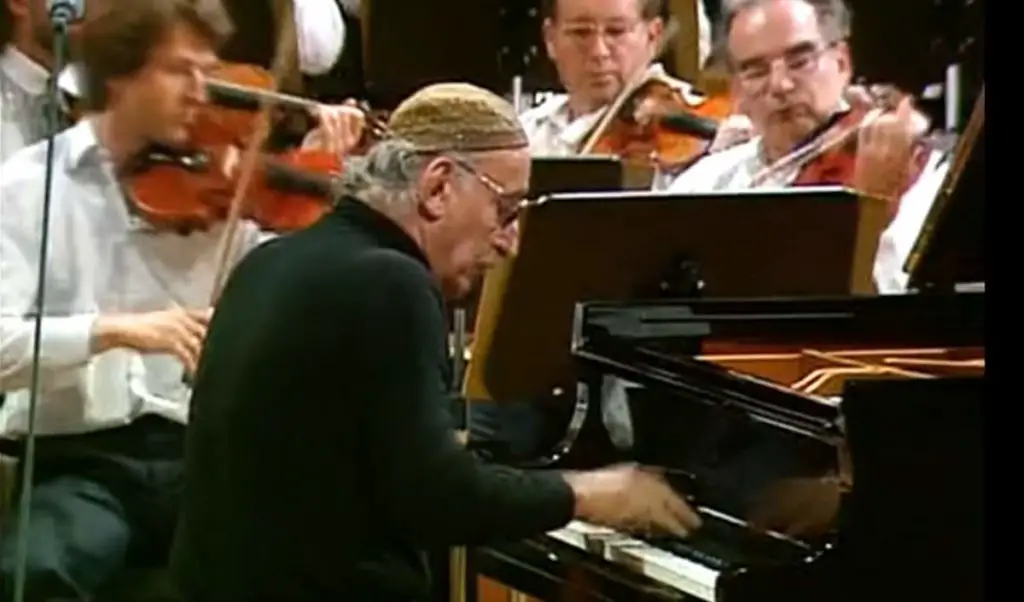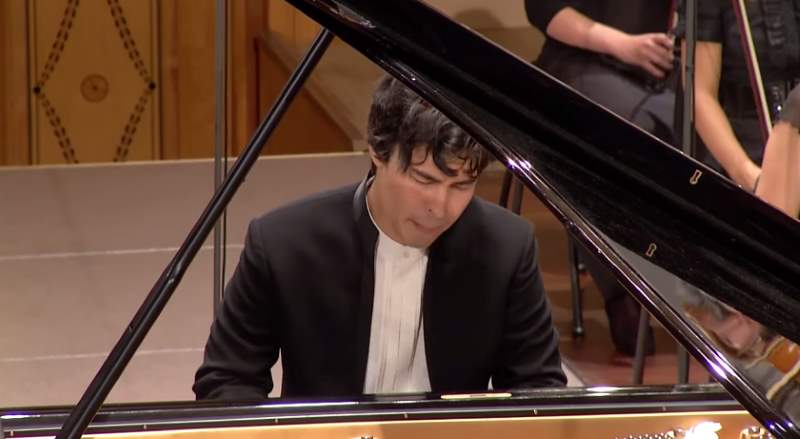Accompanied by the Carl Philipp Emanuel Bach Chamber Orchestra, the Austrian pianist and conductor Stefan Vladar performs Wolfgang Amadeus Mozart’s Piano Concerto No. 20 in D minor, K. 466. Conductor: Hartmut Haenchen. Recorded at the Konzerthaus Berlin in 2005.
Mozart’s Piano Concerto No. 20
Mozart’s Piano Concerto No. 20 in D minor, K. 466, stands out as one of his most dramatic and intense works, offering a contrast to the more lighthearted and lyrical concertos that he composed. Written in 1785, this concerto is significant not only for its stormy and emotional character but also for being one of only two piano concertos Mozart wrote in a minor key (with No. 24 in C minor being the other). The use of D minor gives the piece a dark, brooding quality, which was unusual for the time, as most of his concertos are in major keys and convey a more cheerful tone.
The orchestration of this concerto is particularly rich, featuring strings, woodwinds, horns, trumpets, and timpani. The interplay between the piano and the orchestra is dynamic and full of tension, with the piano often engaging in a dramatic dialogue with the ensemble. The concerto’s intensity and emotional depth have led to comparisons with Beethoven, who admired this work and even composed cadenzas for it.
Piano Concerto No. 20 is also notable for its influence on later composers. Its moody, stormy atmosphere, combined with Mozart’s mastery of form and melody, paved the way for the Romantic era’s more emotionally charged music. The piece is full of contrasts, with moments of lyrical beauty juxtaposed against passages of turbulence and urgency. The concerto remains a favorite in the repertoire for its expressive power and technical brilliance, offering performers and listeners alike a deeply moving and immersive experience.
Movements
1. Allegro
The first movement of Mozart’s Piano Concerto No. 20 in D minor, Allegro, is a dramatic and powerful opening that sets the emotional tone for the entire work. It begins with a tense and foreboding orchestral introduction, with the strings playing a driving, syncopated rhythm that creates a sense of urgency and anticipation. The dark and stormy mood of the D minor key is immediately apparent, and the tension builds as the orchestra introduces the main theme.
When the piano enters, it takes up the theme with equal intensity, but also adds its own voice, creating a complex dialogue with the orchestra. The piano part is both virtuosic and expressive, demanding technical skill and emotional depth from the performer. Mozart masterfully alternates between moments of turbulence and passages of lyrical beauty, with the piano often shifting between these contrasting moods.
The movement follows the structure of sonata form, with an exposition, development, and recapitulation, but Mozart infuses it with a sense of unpredictability. In the development section, the piano and orchestra explore various key changes and thematic variations, heightening the drama. As the movement progresses, the interplay between the piano and orchestra becomes more intense, with the piano asserting itself as both a collaborator and a challenger to the orchestra’s power.
The first movement of this concerto is one of Mozart’s most gripping, full of contrasts between darkness and light, tension and release. Its emotional depth and structural complexity make it a standout in Mozart’s concerto repertoire, captivating listeners with its sense of urgency and passion.
2. Romanze (a five-part rondo -ABACA- with a coda)
The second movement of Mozart’s Piano Concerto No. 20 in D minor, Romanze, offers a striking contrast to the stormy intensity of the first movement. This Romanze is lyrical and tender, written in B-flat major, which gives it a warm, serene quality. The movement is structured as a five-part rondo (ABACA), with a gentle and flowing main theme (A) that recurs throughout, interspersed with contrasting episodes (B and C).
The movement opens with the piano introducing the simple yet elegant main theme, which is characterized by its graceful, song-like quality. The orchestra responds in a delicate and supportive manner, allowing the piano to maintain the central focus. This theme, marked by its understated beauty, creates a sense of calm and introspection, drawing the listener into a more intimate, reflective space.
The contrasting episodes, however, add complexity and depth to the movement. The B section introduces a more animated, almost playful character, with a shift in dynamics and rhythm that provides contrast to the serenity of the main theme. The C section, on the other hand, takes a darker turn, moving briefly into a minor key. This moment of tension serves as a reminder of the dramatic intensity of the concerto as a whole, before returning to the tranquility of the main theme.
The movement concludes with a short coda, which wraps up the Romanze in a peaceful, delicate manner. The second movement’s balance of lyrical beauty and moments of contrast makes it a compelling and emotionally rich part of the concerto, offering a brief respite from the more intense outer movements.
3. Allegro assai (a rondo)
The third movement of Mozart’s Piano Concerto No. 20 in D minor, Allegro assai, serves as a spirited and thrilling finale to the work. Composed in a rondo form, the movement features a recurring main theme interspersed with contrasting episodes, much like a conversation filled with moments of drama, intensity, and resolution. The main theme, introduced by the piano, is lively and urgent, instantly setting a fast-paced, energetic tone that propels the music forward.
The mood of the movement is full of contrasts, with the piano and orchestra exchanging passages of tension and release. The minor key imbues the music with a sense of unease, but Mozart deftly alternates between stormy, darker passages and lighter, more playful sections. The piano takes on a prominent role in driving the momentum, showcasing virtuosic runs and intricate patterns that challenge the performer’s technical skill while maintaining a dialogue with the orchestra.
In the episodes, Mozart explores different moods and tonalities, providing moments of contrast to the main theme. These sections bring brief moments of relief, but the sense of urgency never fully dissipates, maintaining the overall intensity of the movement. The constant interplay between the piano and orchestra creates a dynamic and evolving musical landscape that keeps the listener engaged.
As the movement progresses, the tension builds toward the final recapitulation of the main theme. In a dramatic turn, the movement concludes in a triumphant D major, a bright and unexpected resolution that brings a sense of closure and lightness after the darker undercurrents of the concerto. The Allegro assai is an exciting and virtuosic conclusion to one of Mozart’s most dramatic and emotionally charged concertos, leaving a lasting impression with its blend of intensity, contrast, and eventual triumph.
Stefan Vladar
Born in Vienna, Stefan Vladar is one of Austria’s most remarkable musical personalities. He performs regularly as a conductor and pianist in music centers throughout Europe, America, and Asia.
He was a student of Hans Petermandl at the University of Music and Performing Arts in Vienna. In 1985 he won the 1st prize in the prestigious International Beethoven Piano Competition in Vienna.
Since then, he has performed under the baton of conductors such as Claudio Abbado, Christoph von Dohnanyi, Vladimir Fedosejev, Christopher Hogwood, Louis Langrée, Sir Neville Marriner, Sir Yehudi Menuhin, Seiji Ozawa, Sir Simon Rattle, and Christian Thielemann in appearances with numerous orchestras such as Concertgebouw Orchestra Amsterdam, Academy of St. Martin-in-the-Fields, Bayerische Staatsorchester, Chamber Orchestra of Europe, Chicago Symphony Orchestra, NHK Symphony Orchestra Tokyo, Vienna Philharmonic Orchestra, Vienna Symphony Orchestra, and the Tonhalle-Orchestra Zurich.

As a conductor, he has worked with the Vienna Symphony Orchestra, Camerata Salzburg, Residence Orchestra Den Haag, Bamberg Symphony Orchestra, Tschaikowsky Symphony Orchestra Moscow, Stuttgart Philharmonic, RSO Budapest, Danish Radio Symphony Orchestra as well as the chamber orchestras of Basel, Cologne, Prague, and Zurich, among others.
He has performed together with soloists such as Tzimon Barto, Janine Jansen, Isabelle van Keulen, Viktoria Mullova, Julian Rachlin, Heinrich Schiff, and with singers such as Ian Bostridge, Johan Botha, Jonas Kaufmann, Angelika Kirchschlager, Thomas Quasthoff, Ramon Vargas and Pretty Yende. Stefan has a close long-term musical cooperation with the baritone Bo Skovhus.
Stefan Vladar has been guest artist of the Salzburg Festival, Schubertiade Schwarzenberg, Musikfest Bremen, Schleswig-Holstein Music Festival, Ludwigsburg Schlossfestspiele, Rheingau Music Festival, Piano Festival Ruhr, Schwetzing SWR Festival and the festivals of Aix-en-Provence, Bergen, Bogotá, Edinburgh, Gstaad, Hongkong, Osaka as well as the Opéra Bastille Paris and the Musikverein Vienna. He was an “Artist in residence” of the Bodenseefestival and the Duisburg Philharmonic.
Sources
- Piano Concerto No. 20 (Mozart) on Wikipedia
- Stefan Vladar’s official website



